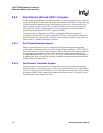
316 Hardware Reference Manual
Intel
®
IXP2800 Network Processor
Media and Switch Fabric Interface
8.9.7 Dynamic De-Skew
The Intel
®
IXP2800 Network Processor supports optional dynamic de-skew for the signals of the
16-bit data interface and the signals of the 4-bit flow control interface or the signals of the 2-bit
SPI-4.2 LVDS status interface. (The flow control interface and the LVDS status interface are
alternate configurations of the same signal balls and pads. They share the same de-skew circuits.)
In both cases, eight evenly-spaced phases of the received clock are generated for each bit time.
As the transition occurs during training a pattern, the best pair of clock phases is identified for
sampling each received signal. An interpolated clock is generated from a pair of clock phases for
each signal and that clock is used as a reference for sampling the data. This provides maximum
quantization error in the sampling of the signals of 6.25%.
Dead Cycle
Requesting reception of training sequence and no
training sequence pending.
Training Training sequence pending.
SPI
Training sequence not pending and SPI data pending
and not requesting training sequence.
Idle CFrame Dead Cycle Always.
Tracking Other State Machine States
SPI SPI SPI SM not entering CSIX-L1 or Training state.
SoF CWord
SPI SM entering CSIX-L1 state and un-flow-controlled
CFrame pending.
Idle CFrame
SPI SM entering CSIX-L1 state and un-flow-controlled
CFrame not pending.
Training SPI SM entering Training state.
Training Training Training SM not entering CSIX-L1 or Training state.
SoF CWord
Training SM entering CSIX-L1 state and un-flow-
controlled CFrame pending.
Idle CFrame
Training SM entering CSIX-L1 state and un-flow-
controlled CFrame not pending.
SPI Training SM entering SPI state.
Table 116. CSIX-L1 Transmitter State Machine Transitions on CWord Boundaries (Sheet 2 of 2)
Current State Next State Conditions


















